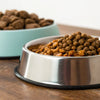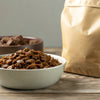Should I Feed My Dog Dry and Wet Food? A Comprehensive Guide
- Houndsy
Table of Contents
- Introduction
- Understanding Dog Nutrition
- Dry Dog Food: The Traditional Choice
- Wet Dog Food: The Tasty Alternative
- Mixing Wet and Dry Dog Food: The Best of Both Worlds
- Tailoring Your Dog’s Diet to Their Needs
- Our Commitment to Simplifying Pet Care
- Conclusion
Introduction
Picture this: it’s mealtime, and your furry friend is staring at their bowl, sniffing at it with a mix of curiosity and disdain. As dog owners, we often find ourselves questioning the best way to nourish our beloved companions. Should we stick to dry kibble, go for wet food, or perhaps consider a mix of both? With the myriad of options available, the decision can feel overwhelming.
In fact, a staggering 60% of pet owners admit to being confused about what to feed their dogs. This confusion often stems from the sheer number of products on the market, each boasting unique benefits. However, the fundamental question remains: should we feed our dogs dry and wet food?
In this blog post, we will delve into the intricacies of dog nutrition, exploring the advantages and disadvantages of both dry and wet food. By the end, you’ll have a clearer understanding of how to meet your dog's dietary needs and make feeding time a delightful experience for both you and your pet.
Let’s embark on this journey together, considering what best suits our furry friends while also reflecting on our own pet-feeding routines.
Understanding Dog Nutrition
Before diving into the specifics of dry and wet food, it's crucial to grasp the basics of dog nutrition. Dogs, like humans, require a balanced diet consisting of proteins, carbohydrates, fats, vitamins, and minerals. Each component plays a vital role in maintaining their overall health:
- Proteins are essential for muscle development and repair.
- Carbohydrates provide energy for daily activities.
- Fats support skin health and provide energy.
- Vitamins and minerals regulate numerous bodily functions, from bone strength to immune support.
As responsible pet owners, it’s our duty to ensure that our dogs receive a balanced diet that meets their unique nutritional needs.
Dry Dog Food: The Traditional Choice
What Is Dry Dog Food?
Dry dog food, commonly referred to as kibble, is a staple in many households. It generally consists of a combination of meat, grains, vegetables, and essential nutrients. The process of making kibble involves cooking, drying, and then packaging, which contributes to its long shelf life.
Benefits of Dry Dog Food
- Convenience: Dry food is easy to store, measure, and serve. It doesn’t require refrigeration and can be left out for longer periods without spoiling.
- Dental Health: The crunchy texture of kibble helps reduce tartar buildup on teeth, promoting better oral hygiene.
- Cost-Effective: Generally, dry food is more affordable than wet food, making it a practical choice for budget-conscious pet owners.
- Weight Management: Kibble can help regulate calorie intake, especially for dogs that tend to overeat.
Drawbacks of Dry Dog Food
- Lower Moisture Content: Dry kibble typically contains about 10% moisture, which may not be sufficient for dogs that don’t drink enough water.
- Less Palatable: Some dogs may find dry food less appealing, especially when compared to the rich aroma of wet food.
Wet Dog Food: The Tasty Alternative
What Is Wet Dog Food?
Wet dog food, often found in cans or pouches, is made from high-quality meat and other ingredients mixed with water or broth. The manufacturing process involves cooking and sealing the food to preserve its freshness.
Benefits of Wet Dog Food
- Higher Moisture Content: Wet food contains approximately 75-80% moisture, making it an excellent option for dogs that need extra hydration.
- Enhanced Palatability: The rich aroma and flavor of wet food can entice picky eaters, ensuring they consume their meals.
- Easier to Chew: For older dogs or those with dental issues, wet food is easier to chew and swallow.
Drawbacks of Wet Dog Food
- Cost: Wet food is generally more expensive than dry food, which can add up over time.
- Storage Challenges: Once opened, wet food must be refrigerated and consumed within a few days to prevent spoilage.
- Less Dental Benefit: The soft texture of wet food doesn’t provide the same dental cleaning benefits that kibble does.
Mixing Wet and Dry Dog Food: The Best of Both Worlds
Why Consider Mixing?
Combining wet and dry dog food can provide a balanced diet that meets a wide range of nutritional needs. This method can enhance the overall feeding experience for your dog, offering variety and improved palatability.
Benefits of Mixing
- Balanced Nutrition: By mixing, you can take advantage of the benefits of both types of food, ensuring your dog receives adequate hydration from wet food and dental benefits from dry food.
- Variety: Dogs can get bored with the same flavor and texture. Mixing foods can keep mealtime exciting.
- Weight Management: Mixing allows for portion control, helping to manage your dog’s weight effectively.
Considerations When Mixing
- Caloric Intake: It’s essential to keep track of the total calories your dog consumes to prevent overfeeding. Consult your veterinarian to determine your dog's daily caloric needs.
- Storage: Proper storage of both food types is necessary to maintain freshness and prevent spoilage.
- Transition Slowly: If introducing a new food, do so gradually to avoid digestive disturbances.
Tailoring Your Dog’s Diet to Their Needs
When deciding whether to feed your dog dry, wet, or a combination of both, consider their unique lifestyle and health requirements. Here are a few factors to take into account:
- Age: Puppies, adults, and senior dogs have different nutritional needs. Puppies may benefit from a mix to support their growth, while seniors might require softer foods.
- Health Conditions: Dogs with specific health issues, such as kidney disease or dental problems, may thrive on one type of food over another or benefit from a mix.
- Activity Level: Active dogs may require higher protein and fat content, which can be found in both dry and wet foods.
Our Commitment to Simplifying Pet Care
At Houndsy, we understand the daily challenges of feeding our furry friends. That's why we’ve designed our flagship product, the Houndsy Kibble Dispenser, to elevate the feeding experience. With its mid-century modern design and ergonomic convenience, it ensures perfect portion control while seamlessly integrating into your home decor.
We believe in making pet care simpler and more enjoyable. Our Kibble Dispenser is designed for convenience, allowing you to dispense kibble without bending down, while its large storage capacity keeps your dog's food fresh.
Conclusion
Choosing the right food for your dog is a crucial part of responsible pet ownership. Whether you decide on dry food, wet food, or a combination of both, understanding the benefits and drawbacks of each option will empower you to make informed decisions. Remember to consider your dog’s individual needs, preferences, and any health concerns they may have.
As you reflect on your pet's feeding routine, we invite you to explore our Houndsy Kibble Dispenser to simplify mealtime while ensuring a healthier feeding experience. Together, we can elevate the way we care for our beloved companions.
FAQ
1. Can I mix dry and wet dog food?
Yes, mixing dry and wet dog food can provide a balanced diet and enhance palatability. However, it’s essential to monitor your dog's caloric intake.
2. How do I transition my dog to a new food?
Introduce new food gradually over a week to avoid digestive issues. Start by mixing a small amount of the new food with the old food, gradually increasing the new food’s proportion.
3. What are the signs that I should change my dog's diet?
Look for changes in your dog’s energy levels, coat condition, weight, and overall health. If you notice any concerning changes, consult your veterinarian.
4. Should I consult my vet about my dog's diet?
Absolutely! Your veterinarian can provide personalized recommendations based on your dog's health, age, and lifestyle.
5. How does the Houndsy Kibble Dispenser work?
The Houndsy Kibble Dispenser allows you to dispense kibble at standing height, ensuring perfect portion control without bending. It features a large storage capacity and an auto-locking mechanism for safety.
By carefully considering your dog’s dietary needs and exploring innovative feeding solutions like the Houndsy Kibble Dispenser, we can create a more enjoyable feeding experience for our furry companions.












